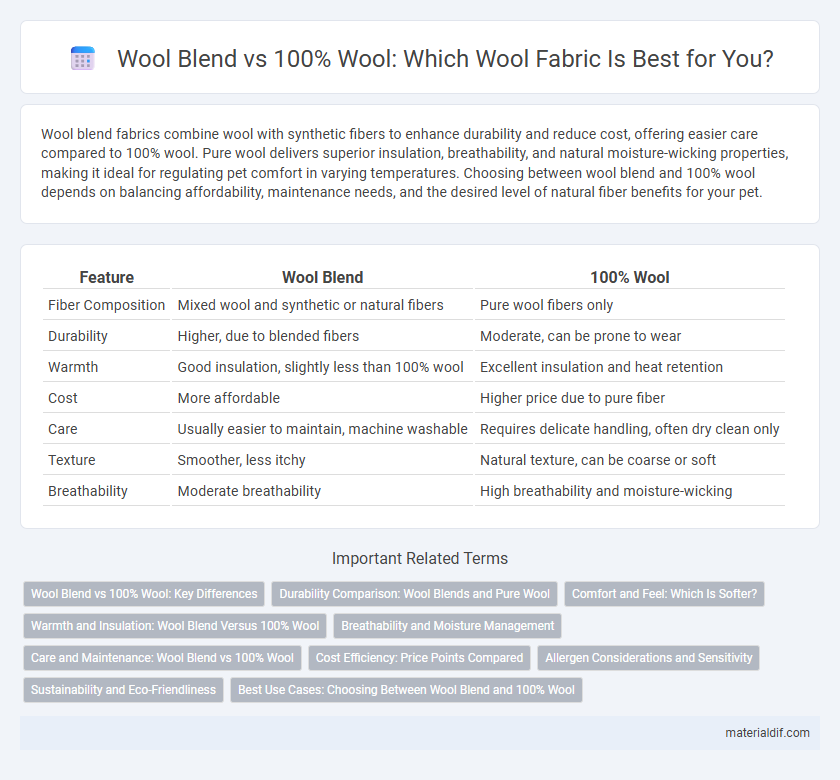Wool blend fabrics combine wool with synthetic fibers to enhance durability and reduce cost, offering easier care compared to 100% wool. Pure wool delivers superior insulation, breathability, and natural moisture-wicking properties, making it ideal for regulating pet comfort in varying temperatures. Choosing between wool blend and 100% wool depends on balancing affordability, maintenance needs, and the desired level of natural fiber benefits for your pet.
Table of Comparison
| Feature | Wool Blend | 100% Wool |
|---|---|---|
| Fiber Composition | Mixed wool and synthetic or natural fibers | Pure wool fibers only |
| Durability | Higher, due to blended fibers | Moderate, can be prone to wear |
| Warmth | Good insulation, slightly less than 100% wool | Excellent insulation and heat retention |
| Cost | More affordable | Higher price due to pure fiber |
| Care | Usually easier to maintain, machine washable | Requires delicate handling, often dry clean only |
| Texture | Smoother, less itchy | Natural texture, can be coarse or soft |
| Breathability | Moderate breathability | High breathability and moisture-wicking |
Wool Blend vs 100% Wool: Key Differences
Wool blend combines wool with synthetic fibers or other natural materials, enhancing durability, wrinkle resistance, and cost-effectiveness compared to 100% wool. While 100% wool offers superior insulation, breathability, and natural moisture-wicking properties, it tends to be more delicate and requires specialized care. Wool blend fabrics often provide greater stretch and easier maintenance, making them suitable for everyday wear, whereas 100% wool is preferred for premium quality and warmth.
Durability Comparison: Wool Blends and Pure Wool
Wool blends combine natural fibers with synthetics, enhancing durability by increasing resistance to wear, shrinking, and stretching compared to 100% wool. Pure wool offers excellent insulation and breathability but can be more prone to pilling and abrasion over time. Blended wool fabrics typically maintain their shape longer and require less maintenance, making them ideal for everyday apparel and high-traffic use.
Comfort and Feel: Which Is Softer?
Wool blend fabrics often combine natural wool with synthetic fibers, resulting in materials that can feel softer and more flexible compared to 100% wool. Pure wool provides a distinct warmth and breathability but may sometimes feel coarser or itchier on sensitive skin. Comfort-wise, wool blends tend to offer enhanced softness and smoother texture while maintaining some wool's insulating properties.
Warmth and Insulation: Wool Blend Versus 100% Wool
100% wool offers superior warmth and insulation due to its natural crimping, which traps heat effectively and wicks moisture away from the body. Wool blends, combining wool with synthetic fibers like polyester or nylon, often sacrifice some insulation capacity but enhance durability and stretch. While 100% wool excels in maintaining consistent body heat in cold conditions, wool blends provide a balance of thermal regulation and wear resistance for versatile use.
Breathability and Moisture Management
Wool blend fabrics often combine natural wool fibers with synthetic materials to enhance durability while sacrificing some breathability compared to 100% wool. Pure wool excels in moisture management by wicking perspiration away from the skin and allowing better airflow, which helps regulate body temperature and keeps the wearer dry. Blended wool may retain some moisture-wicking properties but generally lacks the superior breathability and moisture control inherent to 100% wool fibers.
Care and Maintenance: Wool Blend vs 100% Wool
Wool blend fabrics often require less rigorous care than 100% wool, as they tend to be more resistant to shrinking and wrinkling, making them easier to maintain. Pure wool demands delicate handling, including cold water washing or dry cleaning, and careful drying to preserve its natural fibers and prevent felting. The presence of synthetic fibers in wool blends enhances durability and reduces the frequency of professional cleaning needed compared to 100% wool garments.
Cost Efficiency: Price Points Compared
Wool blend fabrics typically offer greater cost efficiency compared to 100% wool due to lower raw material expenses and easier manufacturing processes. Price points for wool blends can be significantly more affordable while maintaining reasonable warmth and durability, making them ideal for budget-conscious consumers. Although 100% wool commands higher prices reflecting premium quality, its natural insulation and longevity justify the investment for long-term wear.
Allergen Considerations and Sensitivity
Wool blends often reduce allergenic reactions by combining natural wool fibers with hypoallergenic synthetic materials, making them suitable for sensitive skin. In contrast, 100% wool contains lanolin, a natural oil that can trigger allergies or irritation in some individuals. Choosing a wool blend can balance warmth and comfort while minimizing allergic sensitivity for those prone to wool-related discomfort.
Sustainability and Eco-Friendliness
Wool blends often incorporate synthetic fibers that reduce biodegradability and increase environmental impact compared to 100% wool, which is naturally renewable, biodegradable, and requires less energy-intensive processing. Choosing 100% wool supports sustainable farming practices and reduces microplastic pollution associated with synthetic blends. Eco-conscious consumers prioritize 100% wool for its superior lifecycle sustainability and lower carbon footprint.
Best Use Cases: Choosing Between Wool Blend and 100% Wool
Wool blends combine natural wool fibers with synthetic or other natural fibers, enhancing durability, wrinkle resistance, and affordability, making them ideal for everyday wear and active lifestyles. In contrast, 100% wool garments excel in insulation, breathability, and moisture management, perfect for formal occasions and cold weather conditions where warmth and comfort are paramount. Selecting between wool blend and 100% wool depends on prioritizing performance features like longevity and ease of care versus natural fiber purity and maximum thermal regulation.
Wool blend vs 100% wool Infographic

 materialdif.com
materialdif.com